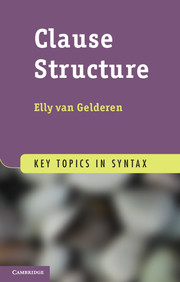Preface
Published online by Cambridge University Press: 05 June 2013
Summary
This book has as its basis the question of how a syntactic derivation is built: top-to-bottom, i.e. representational, or bottom-to-top, i.e. projectionist. Representative sides of this debate are the Cartographic approach, as in Cinque (1999), and the bare phrase structure approach, as in Chomsky (1995). In much literature, these two approaches are assumed to be compatible, but this compatibility is not spelled out. The book is organized Cartographically, i.e. the three layers are examined in great detail, but the underlying message is general cognitive factors should be responsible for the ordering of the phrases in the layers.
Another issue that has caused a lot of debate is whether the argument structure is projected from the verb and then mapped to the syntax, as in e.g. Reinhart (2002), or imposed by the environment of a vP-shell, as in e.g. Borer (2005a, b). In either approach, the issue of how to order the arguments is again crucial: the Thematic Hierarchy and the Uniformity of Theta Assignment Hypothesis (UTAH) take care of this in the projectionist approach; the ordering is Cartographic in the constructionist approach.
Features are central in the Minimalist Program. How are they acquired, are they bundled, and do they project? I discuss various aspects of features and hope that I contribute to a clearer analysis of the TMA features connected with affix-hop. I argue that, unlike in the case of phi-features in English, tense, mood, and aspect features are interpretable on the verb once verb is joined with a certain suffix. It is thus the -ing that has interpretable aspect, the infinitive that has irrealis, and the -ed that has anterior or passive meaning. This provides a more consistent picture of how interpretable and uninterpretable features are used in connection with C, T, ASP, and M.
- Type
- Chapter
- Information
- Clause Structure , pp. ix - xiPublisher: Cambridge University PressPrint publication year: 2013

